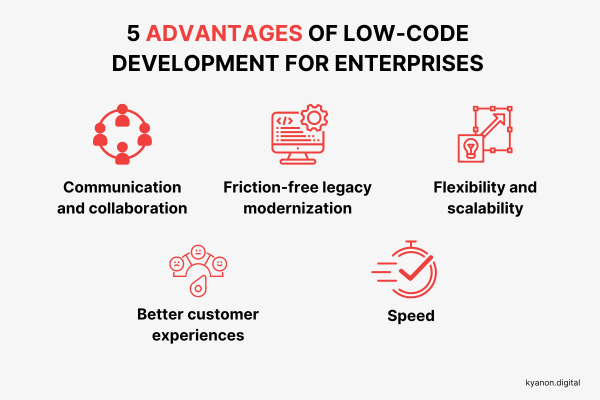Development of low-code applications significantly increases development speed because of several important factors. Development Environment:
Drag-and-Drop Interfaces: Low-code platforms provide visual tools for designing applications. Drag-and-drop elements allow developers to build apps quickly without writing code.
Pre-built Templates and Components A lot of low-code platforms have pre-built templates and components, that allow developers to quickly create and prototype applications without starting from the beginning.
Reduced Coding requirements:
Automated Coding Generation Low-code platforms automatically generate code using the visual model designed by the developers. This reduces manual coding, and speeds up the process of developing.
Reusable Components : Developers are able to reuse components from various projects to cut down on the time spent writing and testing codes.
Collaboration Streamlined:
Low-code platforms come with a variety of tools that facilitate seamless collaboration between teams working on development. These include version control, testing and deployment.
Citizen development: By using intuitive interfaces and reducing bottlenecks that are often caused by insufficient availability of developers, business users and non-developers are able to help in the development of applications.
Rapid prototyping, rapid iteration, and rapid prototyping
Rapid Prototyping Developers are able to quickly create prototypes of ideas that can be validated and feedback collected and analyzed, which leads to faster iterations.
Easy Modifications: Low-code development is visual-oriented, making it much easier to modify and update apps. It also speeds the process of improving and enhancing applications based on feedback from users.
Pre-built Integrations:
API Integrations. A number of low-code platforms offer connectors that are designed to work with popular APIs and services. This could reduce the time to integrate systems.
Data Integration: Built-in tools for data integration simplify the process of connecting databases and other sources of information which speeds up the development process.
Scaling deployment:
Many low-code platforms have the option of deploying applications with one click which can reduce the time and effort needed to set up applications.
Cloud-based Solutions: Cloud platforms with low-code allow developers to concentrate on the logic and functionality of their apps, rather than worrying about deployment logistics.
Overall, low-code development has advantages in terms of speed due to its ability of automatizing and simplifying a variety of aspects of development. This allows for quicker delivery of apps and easier adaptation to evolving needs. Follow the best Low-code Platform for application development url for site recommendations including lowcode no code, mobile app development platforms, mobile app development platforms, paas service, app modernisation, app modernisation, app platforms, app dev platform, cross platform app dev, cloud software applications and more.

The Advantages Of Developing Low-Code In Terms Of Scalability, Flexibility And Scalability
Low-code application development offers several advantages when it comes to the ability to scale and flexibility. These are crucial for building applications that can adapt to business demands and change with the demands of business. These are the main advantages:
Cloud-based Deployment : Many low code platforms are cloud built. This allows applications to grow seamlessly in tandem with cloud infrastructure. This allows businesses to handle the increased workload without worrying about server management.
Auto-Scaling Features: Built-in auto scaling capabilities automatically alter resources in accordance with the requirements. This ensures consistent performance even during peak periods without any manual intervention.
Flexible Architecture:
Low-code platforms encourage modular design, allowing components to independently be developed, evaluated and scaled. This modularity allows for greater flexibility and makes it possible to modify or expand specific components of the application without affecting other parts.
Microservices Integration Support for microservices architecture allows applications to be constructed by combining loosely coupled services, enhancing both flexibility and scalability.
Solutions that can be customized:
Extensibility Low-code platforms typically allow for custom-written code and scripting. Developers can enhance the capabilities of their applications beyond what is available out of the box. This lets businesses meet their own unique requirements.
Third-Party Integrations: The capability to integrate with third-party services and APIs enables companies to integrate additional features and services when needed to enhance the functionality of the application.
Agile Development and Deployment
Continuous Deployment and Delivery: Low-code platforms are able to support agile methods, enabling continuous deployment and integration (CI/CD). This allows rapid deployment of features and updates. The applications can grow rapidly as a result of market trends and user feedback.
Iterative Development: The nature of development using low-code implies that applications can be incrementally improved and scaled up, reducing the risks of large-scale changes and permitting more controlled growth.
Resource Optimization
Resource management that is efficient: Low code platforms optimize resources by offering tools to monitor and control the performance of applications. This enables resources to be utilized efficiently and can be sized up or down according to the need.
Load Balancing : The integrated load balancing function distributes workloads equally among servers. This improves the system's capacity to handle high demand, and guarantees the same performance.
Global Reach
Multi-Region Availability: Lowcode platforms allow for deployment across multiple regions. Businesses can provide users low-latency access to the world. This is essential for applications that serve a global audience.
Localization Support for localization built in, which allows applications to be adjusted for various languages or regional needs. This enhances flexibility for various markets.
Maintenance and Updates:
Maintenance is made easier because of the modularity and visual appeal of low-code apps makes maintenance simpler which allows quick update and bug fixes to be made without long downtime.
Version Control System for Version Control: These integrated versions handle rollbacks and changes in order to make sure that upgrades are able to be installed and previous versions can restored if necessary.
Cost Efficiency:
Low Development Costs - Through cutting down on the amount of code needed, low-code platforms can lower development costs. This allows to expand applications without increasing the development effort and expenditure.
Pay-As-You-Go Models - A lot of low-code platforms have flexible pricing models, such as pay-as-you go that adjusts prices to the actual usage, growth, as well as financial flexibility.
The scalability of low-code applications lets businesses develop strong, adaptable, scalable, and durable applications. These platforms enable quick adjustments to changing demands and efficient use of resources and constant improvement, which ensures that applications expand and change to meet the needs of the business. Take a look at the top rated Enterprise application development with Low-code Platform tips for site tips including low code platforms, build a docker container, azure sql databases, azure sql, push alerts, cross platform app development, app platforms, build with docker, database in azure, jdbc server and more.

Low-Code App Development Offers Many Advantages In Terms Collaboration And Workflow
Low-code application development is a great option for businesses looking to boost team productivity through streamlining development processes. Here are the key advantages: Improved Cross-Functional Collaboration:
Unified Development Environment Low-code platform provides an all-in-one environment where all members of the team such as analysts, developers, designers, stakeholders and others, can effectively collaborate. This helps eliminate any silos.
Visual Development Tool: The drag and drop nature of platforms that utilize low-code allows team members who are not technologically inclined to participate in the process of developing. They are able to ensure that business requirements are accurately analyzed and implemented.
Communication Enhancement:
Real-Time Collaboration Features: Many platforms that use low-code offer real-time collaborative features, including simultaneous editing, comments, and immediate feedback. These features facilitate communication and reduce time spent on back and forth discussions.
Shared Workspaces: Teams may collaborate in shared workspaces, which allows them to view, edit, and discuss aspects of projects, ensuring that everyone is on the same page and working towards shared goals.
Streamlined Workflow Management:
Built-in Project Management Tools: Low code platforms often include integrated project management software that helps teams organize, track, and control, and coordinate their development projects. This includes the assigning of tasks, tracking progress, and managing deadlines.
Workflow Automation Automating repetitive tasks or workflows allows teams to concentrate their energy on more strategic projects and activities which improve the efficiency overall of an organization.
Speedier iteration cycles:
Rapid Prototyping: Low-code platforms enable rapid prototyping and iterative development, allowing teams to develop prototypes, test, and refine applications with shorter time. This allows for feedback to be incorporated quickly into the application, and for rapid improvement.
Agile Development Support Facilitating agile methodologies allows individuals and teams to work in small steps. It also makes it possible to rapidly adjust to changing circumstances.
Accessibility for non-developers
Citizens Development: Lowcode platforms enable people who use business software (citizen developers) to design modifications, maintain, and create applications that do not require a lot of code. This reduces the burden on IT teams as well as developers, enabling them to respond faster to the demands of business.
Training and Onboarding - Intuitive interfaces, comprehensive training materials and intuitive interfaces make it easy to help new members get familiar with the system and enhance the overall team's cooperation.
Centralized documentation, knowledge sharing and dissemination:
Integration of Documentation: Low-code platforms typically include tools to maintain and create documents within the platform, ensuring that all project information is centralized and easily accessible.
Knowledge Repositories. Teams can establish repository of knowledge, with templates and components that can be reused. This can facilitate knowledge sharing and decrease duplication.
Consistency Standardization, Consistency and Standards:
Standardized Components - The use of pre-built, standardized components provides an enduring consistency across the different applications. This makes it easier for the members of the team to understand different parts of a particular project and to work on these components.
Compliance and governance Frameworks built-in for governance ensure that all applications are created in line to organizational standards, regulatory requirements and the quality standards. They lower the risk of not being compliant and ensure that the application meets standards.
Feedback and Improvement Loops
Integrated Feedback mechanisms: Platforms with low-code typically have a built-in feedback mechanisms that allow users to give their feedback to applications. Feedback can then become part of the development.
Continuous Improvement: The capacity for applications to quickly iterate and implement changes based off of feedback, while ensuring they are in line with the requirements of the user as well as business goals.
Visualization of Reporting:
Real-Time Analysis: Analytics and reporting tools included in the software offer real-time insights on project progress as well as user interactions and performance. This allows the use of data to make decisions.
Visual Workflow Maps Software for mapping workflows or processes are helpful for teams to comprehend their workflows. They can also be used to pinpoint bottlenecks, and areas that require improvement.
Low-code development offers many benefits in terms of workflow and collaboration. It allows for the integration of diverse teams together, streamline processes, simplify communication, and enhance teamwork. This creates a more collaborative atmosphere with a quick and efficient development process that results in better-quality applications and more effective alignment between the business goals.
